This pair of radio images taken by the Very Large Array (VLA) shows the planet Jupiter before (left – June 24, 1994) and after (right July 19, 1994) fragments of the comet Shoemaker-Levy 9 struck the planet in 1994. The disk of the planet is in the center of the images. The bright red spots are regions high above Jupiter’s “surface” where electrons interacting with the planet’s intense magnetic field are producing strong radio emission. These “radiation belts” are similar to the Van Allen Radiation Belts discovered above the Earth in 1958.
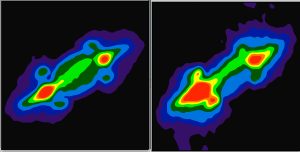
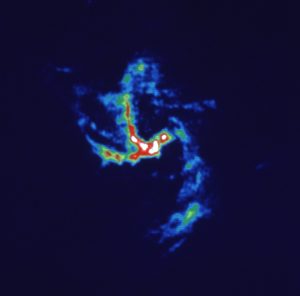
The Spiral in the Heart of our Galaxy
In the heart of our 100,000 light-year wide spiral Milky Way Galaxy lies a miniature spiral of ionized gas only 10 light-years across. The Very Large Array (VLA) caught this gas in the act of orbiting around the supermassive black hole in the core of our Galaxy.
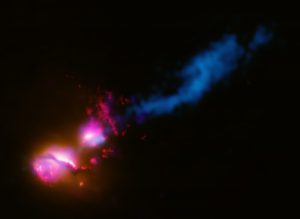
Black Hole Fires Jet at Companion Galaxy
This composite image of the radio galaxy 3C321 shows the jet from a black hole at the center of the larger galaxy, to the lower left, striking the edge of a companion galaxy to the upper right, the first time such an interaction has been found. The image includes X-ray data from Chandra (colored purple), optical and ultraviolet (UV) data from Hubble (red and orange), and radio emission from the Very Large Array (VLA) and MERLIN (blue). A bright, blue spot in the VLA and MERLIN radio image shows where the jet has struck the side of the galaxy and dissipates some energy. The jet is disrupted and deflected by this impact with the companion galaxy.

Flaming Fornax Galaxy
Radio waves are invisible to our eyes, therefore, they do not arrive in any “color” that we’ve ever known. When we take our data and plot it, our artists can assign any color they please to the results. In this image of the famous Fornax radio galaxy, our artist tried a flaming orange coloring for the enormous lobes of gas this galaxy’s black hole sprays out.
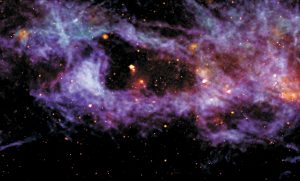
Stellar Outbursts Leave Behind a Galactic Shell
This enormous bubble was blown into the dusty, gas disk of our Milky Way Galaxy by winds and radiation from a few dozen hot, massive stars and the explosions of dying stars. Our Solar System exists in such a cavity. However, this galactic shell (GS 62.1+0.2-18) is 30,000 light years from Earth and measures 1,100 by 520 light years across. It appears so large on the sky that you could line 8 full moons across it. The bright yellow dots are clusters of young, massive stars in the foreground. The Very Large Array (VLA) and the Green Bank Telescope (GBT) traced, in detail, the cool gas in our Galaxy (colored purple, blue and green). The image also overlays radio emission of hot gas (colored orange) and heated dust, imaged in infrared by the Midcourse Space Experiment satellite (colored red).
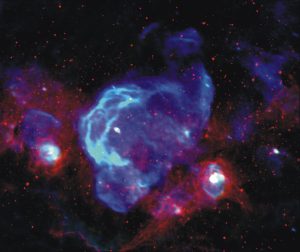
Shells of Exploded Stars
This is a 3-false color image of the region surrounding the W28 supernova remnant (SNR) that is located in our Galaxy. This image was created to look for new supernova remnants through their non-thermal (synchrotron) radio emission. Non-thermal sources in these images are colored blue, while massive star forming regions composed of thermal ionized hydrogen gas are colored white to cyan; warm thermal dust emission has been colored red. Including W28, two SNRs were previously known in this field of view, six new SNRs were discovered from this image.





